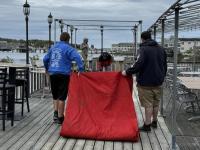Positive School Culture: Why it Must be Prioritized in Order to Improve the Social, Learning, and Teaching Environment of Boothbay Region High School
This is the third of several upcoming feature articles we are publishing which were written by Boothbay Region High School’s AP Language students. According to BRHS AP Language teacher Mark Gorey, the articles are a different incarnation of their Champions of Change proposals. One of the requirements for this assignment was to cite research sources.
“A school’s culture has more influence on life and learning in the schoolhouse than the president of the country, the state department of education, the superintendent, the school board, or even the principal, teachers, and parents can ever have.” – Roland S. Barth, The Culture Builder.
In the 2008-2009 school year, the student enrollment for Boothbay Region High School was 256. 10 years later, in the 2018-2019 school year, the number of students had dropped a notable 29% to 183 students (“Student Enrollment”). But the students that have left are not the only ones who are unhappy with the Boothbay Region High School. A significant population of the students in our high school have, at some point in their high school career, expressed a wish to leave (Figure 1). I was one of these students. This should not be the case and must be changed. Students should not feel they have to leave our school system in order to fulfill their needs. In order to dig down to the roots of the problem, we must ask one simple question: why? Why are students leaving our school system without anyone batting an eye, or trying to change the reason(s) that pushed them away in the first place? Although it is not the only reason for Boothbay’s declining enrollment, one of the major contributing factors is the culture at Boothbay Region High School.
“School culture is the system of beliefs, values, norms, and expectations that governs the feelings and subsequent behaviors of all school constituents” (Fiore). School culture strongly influences, not only students, but staff and faculty members alike. To put it simply: a positive culture will have a positive impact on a school. Conversely, a negative culture will have a negative impact on a school. If a school has a strong and positive culture, “Students learn and enjoy learning, teachers teach and enjoy teaching, principals lead and enjoy leading, and parents support and enjoy supporting” (“School Climate”). Though some may say that school culture should not have the priority over students’ academic achievement, we can not graduate accomplished students in an environment that does not allow for their success. As it stands now, our culture is inadequate. Bonds between students are being ruptured by a sense of unhealthy competition, student voices are not being heard or respected, and the overall aura of our school on a daily basis is that of unhappiness. In walking through the hallways alone, you can hear remarks from all types of students about wishing they were elsewhere and not at school.
To make a change for the better, I am calling for the creation of a positive school culture within the Boothbay Region High School. If we create more positive connections and relationships between students and staff, establish a Student Advisory Board, and create more school-wide involvement and engagement, we will begin to see students rising to their full potential because the culture around them finally enables them to do so. Students will then begin staying within our school system and flourishing like never before.
Over the last decade, the number of students that have left our school system has been far too many to count on just two hands. Mentioned earlier was a 29% decrease in student population over ten years, but this disadvantageous percentage is only growing. In the 2009-2010 school year, the student enrollment for Boothbay Region High School was around 260. Now, in the 2019-2020 school year, the enrollment is around 177 (Welch). That is a 32% decrease in the student population. Though there are many possible factors that could have resulted in such a drastic decrease, a major contributing aspect to this decrease in enrollment is school choice. For students who do not live directly in a town with a high school, the town in which they live helps to pay for these students to attend high school wherever they would like. This puts school choice in the hands of these students and their families. I am one of them. I have lived on Southport Island my whole life and attended Southport Central School from kindergarten through sixth grade. As soon as I entered high school, I was unhappy, so I did not let my school choice advantage go to waste. I researched, inquired, and even toured other schools. I wanted to leave because I was dreading coming to school every day. I wasn’t happy at Boothbay Region High School, surrounded by unhappy students that were tearing each other down as an outlet of their own misery at Boothbay Region High School. So I explored other options. But now there are others experiencing these same feelings I had, feelings that I wouldn't wish on anyone. According to a survey answered by 120 members of the BRHS student body, 43.3%-- 52 of the 120 students-- agree with the following statement: “the culture of Boothbay Region High School is stifling, or keeping me from reaching my full potential in some way.” 43.3% of students feel the same way I felt. It is only a matter of time before they explore other options as well. Who knows whether they will stay, like I did, or leave like the handfuls of students that have been unsatisfied with BRHS. These students that have left our system did not only disperse to public schools but private schools just the same. The variety of schools to which BRHS has lost students ultimately proves that it was the aspects within the alternative schools that Boothbay Region High School just could not compete with. Whether it is the academics, the people, or just the overall aura of the other schools, it was BRHS could not offer that drew our students away.
Even though the students that left could not see them, I stayed because I realized that there was the potential to make a change. Boothbay has amazing and qualified teachers, a variety of course offerings, sports and extracurriculars, resources that can be utilized by every type of student and, most importantly, a lot of room for improvement. BRHS has the potential to start attracting and keeping students. These students could begin to blossom, as people and academically within our school. We aren’t reaching this now, as our declining enrollment has proven, but that does not mean we can’t start. So, rather than leaving and taking advantage of my school choice, I began looking at it as the starting line for improving our school’s culture. We, as a school community, have the power to change something as drastic but as simple as the environment in which our students walk into every day. So what can we do to make students start choosing Boothbay?
The first thing when looking at school culture is taking a step back to observe the overall school dynamic and how all members interact with one another. School culture is all about building positive connections. It is about cooperation from all aspects of a school system, and building comfortable gateways for communication to flow (Shafer). Progress will come from creating these constructive relationships within the school system. Presently, there is a sense of detachment and disengagement within our school that has been recognized by students and staff, and is preventing this constructive collaboration. The interim principal, Mrs. Campbell, acknowledges this: “I do have a sense at times that we can be a little disconnected, and so one of the things that I get excited about is, ‘how can I help to make better connections and relationships?’ Let's bring folks together. Right now, we’re all sort of in our own different... I guess boxes, our own sort of areas, and I'd like to see an opportunity for folks to really come together to celebrate the school. Maybe some folks might eye-roll, but I truly believe, I genuinely believe, that a school is a family. it's its own community.”
Campbell shares that a positive school culture, like any end goal, can only be reached in small steps. More specifically to the topic, she suggests creating “common experience, common language.” Bringing the students and staff together through common experience and opportunity is a major change that can be made in order to create these positive connections. Currently, the only common ground that students and staff share is getting up in the morning and going to school for 7 hours a day, 5 days a week. In creating a new and engaging platform for common ground, students and staff will be united in a whole new light. One example of common ground that BRHS is beginning to see is the practice of First Friday activities. On the first Friday of every month, students are encouraged to sign up for one
staff-run activity to participate in. These activities take many different forms such as finger painting, basketball, kickball, board games, jewelry making and even academic study. This wide range of activities that appeals to all types of students helps to engage the entire student body. This is the type of common experience that sits at the base of a positive school culture. A collaborative and engaging experience outside the typical classroom setting that tailors to all students, because, “a positive school culture is going to look different for each student” (Crocker).
When these positive connections are made and the school becomes more collaborative, students will feel comfortable expressing their ideas or concerns to leaders among the student body. These student leaders will convey these ideas or concerns to staff members, and the staff will inform the decision-makers within the school system. One example of this system in action is student government. Currently, our student government prioritizes dance organization and fundraising. Though students may have ideas for improving our school, these ideas are not expressed. Our student government’s preoccupation with short-term ideas drowns out the long-term improvements for our school. If a new group within our student body was created, prioritizing ideas and concerns that deal with improving our school, our school could have the potential to change aspects that, through the students’ eyes, are in need of improvement. This type of group is called a Student Advisory Board. This type of leadership group would consist of all types of students ranging in social status, academic status, grade, and gender. This board would discuss ideas or concerns that have surfaced from either within the group or within the student body, and convey these to the staff advisory group-- a group consisting of administrators and one representative from each discipline. Mr. Crocker, BRHS’s dean of students, adds that “a school reflects its leaders.” When strong leadership is established by the administration of a school, it will have a “trickle-down effect.” Presently, the leadership in the Boothbay Region High School has been inconsistent with the changing of the principal several times this year. Mr. Cherry, an English teacher within our school, acknowledges that presently “there's a lack of clear leadership at the top.” Leadership is something that is learned, so another major change that needs to be achieved is establishing a clear and strong system for the students to emulate. Once this change is made, the Student Advisory Board will be able to succeed.
Mrs. Campbell agrees that a group like this is “imperative.” Mr. Crocker recognizes that, “If kids are given guidance and opportunity they will run with it.” He understands that the school needs to consist of more “student-given guidance and opportunity instead of [administrators] just saying what to do and how to do it … The more voice you give to students, the happier they will be. The more buy-in you have [from students], the more likely it is to continue.” This necessary student-given guidance will be created by this Student Advisory Board. When such a group is created, it opens up a line of clear and constructive communication between students and staff: a positive connection. This will leave the door open for students to continue expressing themselves, and the school system will begin to see positive outcomes.
In Plainfield, New Hampshire, there is a private high school called Kimball Union Academy (KUA). They have built their foundation on trust and belonging, and see students both doing well in school and doing good in the world because of these motives. The Head of Outreach at KUA, Kevin Ramos-Glew, is a strong believer and advocate for this type of positive foundation. “It’s the core of who we are—the safety, inclusivity, diversity, the sense of belonging.” A large contributor to their school’s positive principles is a special initiative at Stanford University called The Belonging Project. This project strives towards emotional health and wellbeing through the creation of positive connections, in order to see students’ success in all aspects of life. This project is built on four main goals, which have been adapted both at Stanford as well as Kimball Union Academy. “We have done research into Belonging through Stanford’s Positive Psychology studies and firmly believe that when kids/people feel safe and a strong sense of belonging/contribution/value, they can learn. We simplify it to top brain vs. bottom brain...which says that you can’t access your top brain (learning) if your reptilian (bottom) brain is activated in search of safety” (Ramos-Glew).
This known principle at KUA helps to foster a sense of belonging, which is an absolute necessity in a successful school. If students feel a sense of safety and belonging in the classroom, they will be able to thrive. “Individuals develop a sense of belonging when they feel connected to other people, especially those who share their distinct life experiences, interests, or goals. University activities that foster a sense of belonging promote mental and physical health and help individuals to flourish in all aspects of their lives,” (Department of Psychiatry). Students and faculty share these types of “distinct life experiences, interests, or goals.” This common ground is school.
As well as prioritizing The Belonging Project, KUA also practices the previously stated concept of a student-run leadership group: “Ten years ago we shirted to a student-centered leadership program in which they generate and execute a great deal of the planning, programs and even school [meetings]. We support and offer ideas, but really encourage the kids to take it and run with it” (Ramos-Glew).
This student group has created a foundation of trust, empowerment, and comfort among the students of this high school knowing that their voices are being heard. At Boothbay Region High School, we are seeing the opposite of this: student voices being stifled, not being heard, and not being respected. This school year, BRHS made the decision to change the failing grade from a 60 to a 70. This new standard will be enforced starting in the 2020-2021 school year. Before this decision was made, however, a survey was sent out by the administration to gather student input on this topic. The results of the survey showed clearly that the majority of students wanted to keep the failing grade at a 60, and not change it to a 70. Nonetheless, their ideas were tossed aside and the grade was changed anyways. The decision was made with disregard to the wide-held student beliefs that opposed this policy change. This is just one example situation of many in which student voices are trampled over by the voices of adults with more authority.
Changing this concept is more than necessary. When students know that their ideas are going to be heard, and know that their input is just as important as those of adults, it creates that sense of belonging that has so concretely been linked to success in and outside the classroom. This is the type of feeling that students should be carrying with them to BRHS everyday, not a feeling that their opinion is irrelevant.
While culture has a major impact on the atmosphere within a school system, that is not the only aspect it is capable of improving. Culture affects students’ learning just as greatly as it does the overall environment of the school. In fact, “School culture is the secret to school successes” (Demerath). Having a positive school culture is scientifically proven to improve students' academic achievement. The best grounds for student growth, in all aspects, is a positive climate in which we can flourish. A study conducted in 2012 by researchers at Yale University, spreading across 63 fifth/sixth-grade classrooms (1,399 students), observed how emotional engagement and a positive climate impacted students' academic achievement. Compounded with previous studies, it was concluded that, “Classrooms high in positive climate and low in negative climate are characterized by a sense of connectedness and belongingness, enjoyment and enthusiasm, and respect. Prior research shows that students in classrooms with these characteristics engage more in learning (Furrer & Skinner)...” (Reyes, Brackett, et al, 707). As well as higher student engagement in the classroom, positive culture has also been linked to higher student academic success. “In one study, middle school students who reported higher levels of engagement were 75% more likely to have higher grades and attend school regularly than those with lower levels of engagement (Klem & Connell, 2004)” (Reyes, Brackett, et al, 700). The grades achieved by students in a positive environment proved to be significantly higher than the grades achieved in a negative environment, as concluded by the study. “Specifically, for every one unit increase in CEC [Classroom Emotional Climate], grades increased by 3.83 points, which corresponded approximately to half a letter grade higher (e.g., from a B to a B+)” (Reyes, Brackett, et al, 706). Classrooms with a positive environment have a higher CEC, and classrooms with a negative environment have a lower CEC. Not only do students in a positive climate experience a stronger sense of involvement in the classroom, but their academic status is also far higher than students in a negative environment. In settings where a student’s idea can thrive, their academics will as well.
When a school community fosters a sense of belonging, students will be more motivated and comfortable to achieve new levels of success. But, here at BRHS, there is a strong sense of competition. When students are submerged in unhealthy competition, they will perform in the opposite manner. Unhealthy competition creates a negative environment.
The hunger to compete within BRHS when it comes to grades stifles our students, corrupts our sense of belonging, and crushes the common ground. Whether the result of this competition presents itself as a fear of being wrong, a fear of speaking up in class, test anxiety, or even believing that your B is not a good enough grade, this problem is prevalent enough that the BRHS administrators have disabled students’ access to their Grade Point Averages (GPAs) in order to prevent students from viewing and therefore comparing their GPAs with their peers. However, this is not unique to Boothbay. The college application process, the fight among class members for a top 10 spot in their graduating class, the contest for valedictorian and salutatorian; all of these are examples of how schools promote unhealthy competition. It is not specific to Boothbay, but to all high schools across the nation. In order to mend this break between reality and students’ perceived “failure,'' everyone needs to be accepting of everyone. Everybody must be more empathetic towards everybody.
No matter the letter grade we are achieving, the competition should not be between each other. By prioritizing and developing this strong sense of acceptance, the bridge between students can be rebuilt. One way of doing this would be increasing school involvement and interaction. At the nearby Lincoln Academy in Newcastle, Maine, there are weekly assemblies that take place in order to increase the feeling of community and belonging within the school system. These assemblies are referred to as “Community Meeting.” These assemblies provide the opportunity for students, staff, and even members of the community to take center stage; whether this looks like a musical performance, a presentation, an announcement, a poetic reading, or the routine awarding of points to advisor groups as a continuation of the year-long game between advisors, this weekly practice brings the school community together in an admirable way. This type of activity could benefit BRHS just as it has Lincoln Academy. By creating time for a routine assembly (weekly, biweekly monthly, etc.) that promotes positive school culture through involvement, it will get the students, staff, and even community members on the same route to the ultimate end goal: an environment in which students are comfortable, and can succeed.
School culture is a subject that should not be taken lightly. The recognition of our desired objective, the creation of positive connections within the school system, and the prioritization of such an environment are the first steps to seeing a result that is beneficial to everyone within the school system. When a positive culture is created, students will begin to choose Boothbay Region High School. Enrollment will only grow with this cultivation of a better atmosphere, and the results will benefit all who are involved with the school system. A positive culture is the breeding ground for positive outcomes. Paraphrasing Thoreau, we must stop clipping the leaves of this problem in hopes of a change, and instead dig down to the roots.
Works Cited
Campbell, Tricia. Personal interview. 4 March 2020.
Cherry, Michael. Personal Interview. 3 March 2020.
“Community Survey.” 5 February 2020.
Crocker, Allan. Personal Interview. 5 March 2020
Demerath, Peter. “School Culture Drives Student Achievement – UMN CEHD.” CEHD
Vision 2020, 11 Jan. 2018, https://cehdvision2020.umn.edu/blog/strong-school-culture/.
Department of Psychiatry and Behavioral Sciences. “The Belonging Project at Stanford University.” Department of Psychiatry and Behavioral Sciences, https://med.stanford.edu/psychiatry/special-initiatives/belonging.html.
Fiore, Douglas J. “Creating Connections for Better Schools: How Leaders Enhance School Culture.” New York: Routledge, 2013. PDF.
Ramos-Glew, Kevin. Personal Interview. 2 January 2020.
Reyes, Maria R., et al. “Classroom Emotional Climate, Student Engagement, and Academic Achievement.” Yale Center for Emotional Intelligence, American Psychology Association, 2012, http://ei.yale.edu/publication/classroom-emotional-climate-student-engagement-and-academic-achievement/.
“School Climate Improvement Action Guide for Working with Students. School Climate Improvement Resource Package.” National Center on Safe Supportive Learning Environments, National Center on Safe Supportive Learning Environments. 31 Dec. 2016,
https://eric.ed.gov/?q=improving+schools+&ft=on&id=ED580912].
Shafer, Leah. “What Makes a Good School Culture?” Harvard Graduate School of Education,
https://www.gse.harvard.edu/news/uk/18/07/what-makes-good-school-culture.
“Student Survey.” 3 February 2020.
“Student Enrollment Data.” Student Enrollment Data | Department of Education,
https://www.maine.gov/doe/data-reporting/reporting/warehouse/student-enrollment-data.
Welch, Dan. Personal Interview. 25 November 2019.
Event Date
Address
United States





















